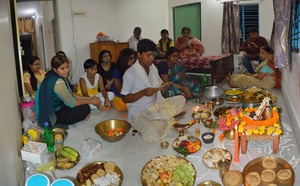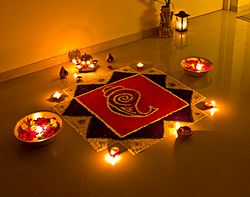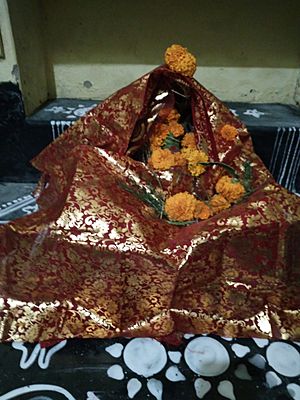Lakshmi Puja facts for kids
Quick facts for kids Lakshmi Pooja |
|
|---|---|
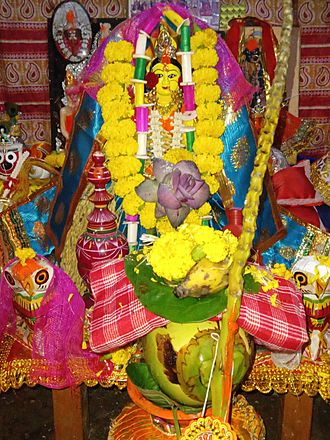
Lakshmi puja in an Indian Home
|
|
| Observed by | Hindus |
| Type | Hindu |
| Date | [[ | Lua error in Module:Wd at line 1575: attempt to index field 'wikibase' (a nil value). ]] māsa (amānta) / [[ | Lua error in Module:Wd at line 1575: attempt to index field 'wikibase' (a nil value). ]] māsa (purnimānta), Lua error in Module:Wd at line 1575: attempt to index field 'wikibase' (a nil value). pakṣa, [[ | Lua error in Module:Wd at line 1575: attempt to index field 'wikibase' (a nil value). ]] tithi |
| Frequency | annual |
| Related to | Diwali and Tihar |
Lakshmi Puja is a special Hindu festival. It happens once a year. People celebrate it on the new moon day (called Amavasya) during the dark half of the month. This is in the Hindu calendar month of Ashwin or Kartik.
The puja (worship) takes place on the third day of Tihar. It is also a main part of the Deepawali festival. In Hinduism, Lakshmi is the goddess of wealth and good fortune. She is also the wife of Lord Vishnu.
Many people believe that Goddess Lakshmi visits her followers on this day. She brings gifts and blessings. To welcome her, families clean their homes. They also decorate them with bright lights. People prepare special foods and sweets as offerings to the goddess.
Contents
How Lakshmi Puja is Celebrated
People believe that Goddess Lakshmi travels across the Earth on the night of Lakshmi Puja. To welcome her, people open their doors and windows. They also place diya lights (small oil lamps) on windowsills and balconies. This invites her into their homes.
As evening comes, people put on new clothes or their best outfits. Then, they light the diyas. They offer pujas to Goddess Lakshmi. Depending on the region, they might also worship other gods. These often include Ganesha, Saraswati, and Kubera. Lakshmi represents wealth and good luck. People ask for her blessings for a good year ahead.
On this day, families often honor mothers. Mothers are seen as a part of Lakshmi. They bring good fortune and success to the home. Some Hindus light small clay lamps filled with oil. They place these in rows along temples and houses. Some even float diyas on rivers. This day is also a time to visit family and friends. People exchange gifts and sweets.
It is a common belief that Lakshmi loves clean places. She will visit the cleanest house first. Because of this, people also worship the broom. They offer it haldi (turmeric) and sindoor (red powder). Lakshmi Puja involves worshipping five gods together. Ganesha is worshipped first. He is known as the remover of obstacles. Goddess Lakshmi is worshipped in three forms:
- Mahalakshmi, the goddess of wealth.
- Mahasaraswati, the goddess of learning.
- Mahakali, a powerful goddess.
Kubera, who is the treasurer of the gods, is also worshipped.
The best time for the puja is in the evening. This is when the new moon phase is active. After the puja, many people go outside. They celebrate by lighting fireworks. Children enjoy sparklers and small fireworks. Adults light bigger ones like rockets. Fireworks show the joy of Diwali. They are also believed to scare away bad spirits. After the fireworks, families enjoy a feast. They share conversations and mithai (sweets).
Celebrations in India
In Bengal, Goddess Lakshmi is worshipped five days after Vijaya Dashami. This is on the full moon day of Sharada. It is called Kojagori Lokkhi Pujo. On this night, the goddess is usually worshipped after dark. She is also worshipped using banana trees or special clay pots. A small boat with five drums is also part of the worship. These drums hold grains, gold, silver, cotton, and cowrie shells. Lakshmi is also worshipped the night before Diwali. This is known as Dipanwita Lokkhi Puja. She is also worshipped on Thursdays in the month of Bhadra (August–September). People worship her as rice placed in a pot. This pot is changed every year. This worship also happens in the month of Poush (December–January).
In Assam, Lakshmi Puja is celebrated five days after Vijoya Doshomi. Family members help decorate home entrances. This is to welcome Goddess Lakshmi. Offerings usually include sweets, lentils, and fruits.
Celebrations in Nepal
Lakshmi Puja is a part of Tihar in Nepal. Tihar is Nepal's second biggest festival. It lasts for five days. These days include:
- Kag (crow) Tihar
- Kukur (dog) Tihar
- Gai (cow) Tihar in the morning and Lakshmi Puja at night
- Maha Puja (self-worship)
- Goru (Ox and Bull) Tihar and Gobardhan Puja
- Bhai Tika (Bhai Dhooj)
On Lakshmi Puja in Nepal, people buy gold and silver. They also buy precious gemstones and new utensils. These are made of copper, brass, and bronze. This is a sign of good luck and wealth. These items are then used to worship Lakshmi at night. Nepalese people clean the worship area with holy water, cow dung, and red mud. They light up their whole house with candles and lamps. After Lakshmi Puja, people gather with friends to play Deusi and Bhailo songs.
The Puja Ritual
To begin the puja, homes are cleaned. A rangoli design is drawn at the doorstep. This is to welcome Goddess Lakshmi.
Steps for the Puja
Before starting the puja, Hindus clean and purify the space. They might burn "Guggal" or Loban (a type of resin). Its smoky, sweet smell helps purify the air. Ready-made incense cones are also used.
Once the area is clean, the puja begins. A new cloth is placed on a raised platform. Grains are spread in the center of the cloth. A kalasha (pot) made of gold, silver, or copper is placed on top. The kalasha is filled three-quarters with water. A betel nut, a flower, a coin, and some rice grains are added. Five types of leaves are arranged around it. If specific leaves are not available, mango leaves are used. A small dish of rice grains is placed on the kalasha. A lotus flower is drawn on the rice with turmeric powder. The idol of Goddess Lakshmi is placed on top of the kalasha. Coins are placed around it.
The idol of Lord Ganesha is placed in front of the kalasha. This is on the right side, pointing towards the south-west. Ink and business account books are also placed on the platform. Special oils are used for the puja. A "Panchmukhi Diya" (five-faced lamp) with five wicks is lit. Another special lamp is lit in front of Lord Ganesha.
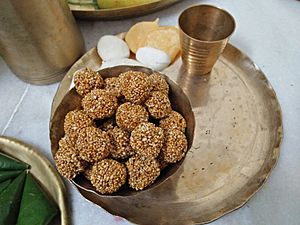
The puja starts by offering turmeric, kumkuma, and flowers to Goddess Lakshmi. Then, haldi, kumkum, and flowers are offered to water. This water is later used for the puja. The river goddess Saraswati is invited to be part of this water. Goddess Lakshmi is worshipped by reciting special prayers. Her idol is placed in a plate. It is bathed with panchamrita. This is a mix of milk, curd, ghee (clarified butter), honey, and sugar. Then, it is bathed with water containing a gold ornament or a pearl. Her idol is cleaned and placed back on the kalasha. A special lamp is lit in front of Goddess Lakshmi.
Offerings are made to Goddess Lakshmi. These include sandal paste, saffron paste, and garlands of cotton beads or flowers. Ittar (perfume), turmeric, kumkum, abir, and gulal are also offered. Flowers like Lotus, Marigold, Rose, and Chrysanthemum are given. Leaves of the Bael (wood apple tree) are also offered. An incense stick is lit, and dhoop (incense) is offered. Later, sweets, coconut, fruits, and tambul (betel leaf preparation) are offered. Puffed rice and batasha (Indian sweets) are placed near the idol. Puffed rice, batasha, coriander seeds, and cumin seeds are poured over the idol.
In villages, a pot made of bamboo canes is used. It is called a 'Nana'. This pot is filled with freshly harvested paddy (rice). Rice and lentils are also kept with the paddy. The 'Mana' represents Mahalakshmi. The Goddess is worshipped by offering fruits, coconut, banana, grass, amla (Indian gooseberry), curd, turmeric, flowers, and incense. It is a tradition to read the holy book, "Lakshmi Puran," during the puja.
A Swastika symbol is drawn on the safe or vault where valuables are kept. It is worshipped as a symbol of Lord Kubera.
At the end of the ritual, Aarti is performed. This is a special prayer with lamps. It is dedicated to Goddess Lakshmi. The Aarti is done with a small bell in a calm atmosphere. Lakshmi Puja is also celebrated in Indo-China.


